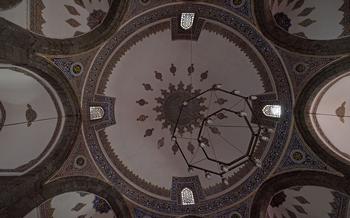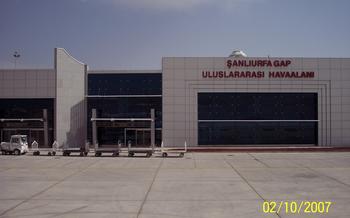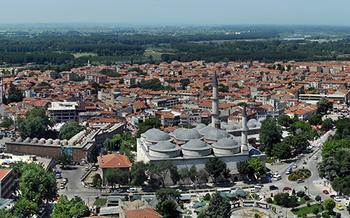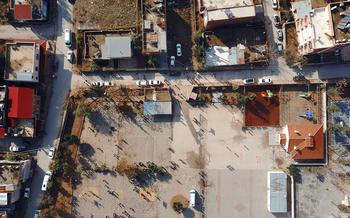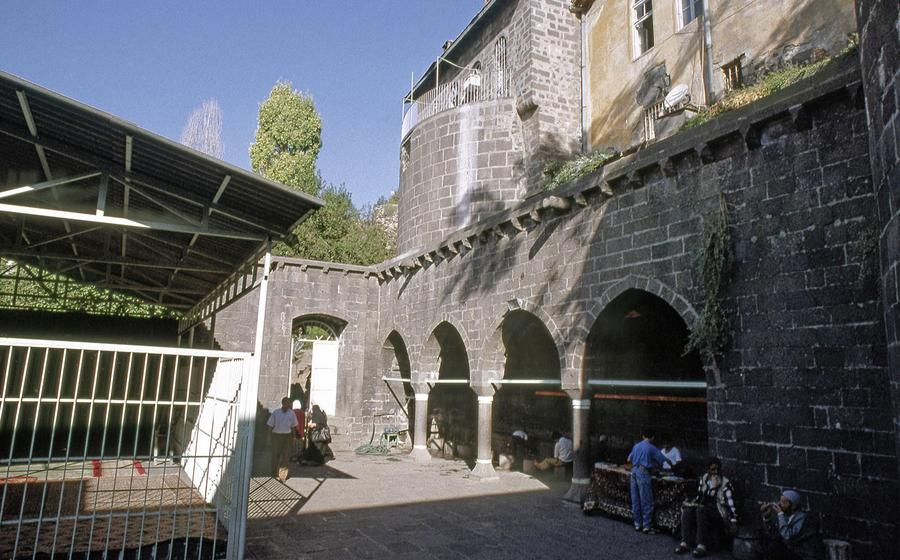
Hz. Süleyman Mosque
- History of the Hz. Süleyman Mosque
- Architectural Features
- Interior Decorations
- Religious Significance
- Cultural Importance
- Visiting the Mosque
- The Call to Prayer
- Prayer at the Mosque
- The Courtyard
- The Minaret
- The Mihrab
- The Minbar
- Surrounding Area
- Local Customs and Traditions
- Insider Tip
History of the Hz. Süleyman Mosque
The Hz. Sü heritage, was constructed during the Artuqid period, a time of great architectural and cultural flourishing in the region. The exact date of its construction is unknown, but it is believed to have been built between 1155 and 1185 AD during the reign of Sultan Süleyman II. The architect responsible for its design is not definitively known, but it is attributed to the renowned architect, Ibn al-Khashshab, who was renowned for his intricate and innovative architectural style.
Throughout its long and storied history, the Hz. Süleyman Mosque has witnessed numerous significant events. It served as a prominent center of Islamic worship and learning during the Artuqid period and continued to play a crucial role in the religious and cultural life of Diyarbakır under subsequent rulers. Over the centuries, it underwent several renovations and restorations, each contributing to its unique architectural character.
Architectural Features
The Hz. Süleyman Mosque stands out for its unique architectural style, a blend of Seljuk and Ottoman influences. Constructed using local basalt stone, the mosque's exterior exudes a sense of solidity and grandeur. Its layout follows the traditional Islamic plan, comprising a rectangular prayer hall, a courtyard, a minaret, and a mihrab.
The mosque's prayer hall is supported by massive stone pillars and arches, creating a spacious and airy interior. The use of intricate tilework and calligraphy adds to the mosque's aesthetic appeal, while the stained glass windows filter sunlight, casting a warm and colorful glow within.
The mosque's minaret, a prominent landmark of Diyarbakır's skyline, is a testament to the skills of the mosque's architects. Its slender structure, adorned with intricate carvings, tapers upwards, providing breathtaking views of the city and the surrounding countryside.
The overall design of the Hz. Süleyman Mosque reflects the architectural prowess of its builders and serves as a testament to the fusion of Seljuk and Ottoman architectural styles.
Interior Decorations
The interior of the Hz. Süleyman Mosque is a feast for the eyes, adorned with intricate tilework, beautiful stained glass windows, and a unique mihrab and minbar. The walls are covered in colorful tiles, each tile meticulously hand-painted with intricate patterns and designs. The tiles depict scenes from the Quran, as well as geometric and floral motifs. The stained glass windows, which date back to the 16th century, fill the mosque with a soft, colorful light. Depicting scenes from Islamic history and culture, they are considered some of the finest examples of Islamic stained glass art. The mihrab, which indicates the direction of Mecca, is a masterpiece of Islamic architecture. It is made of intricately carved marble and features a beautiful mosaic of tiles. The minbar, from which the imam delivers sermons, is also made of marble and features delicate carvings and inscriptions. The overall ambiance and atmosphere of the interior are one of awe and inspiration. It is a space that invites contemplation and prayer.
Religious Significance
The Hz. Süleyman Mosque holds immense religious significance for the local Muslim community. It serves as a central place of worship and spiritual guidance for the faithful. The mosque has played a pivotal role in the religious history of Diyarbakır, contributing to the city's rich Islamic heritage. Over the centuries, countless Muslims have gathered within its walls to offer prayers, seek knowledge, and connect with their faith.
The mosque is also a significant landmark in the broader Islamic world. Its architectural grandeur and historical importance attract visitors from across the region and beyond. Muslims from various countries come to Hz. Süleyman Mosque to witness its beauty, experience the spiritual atmosphere, and reaffirm their connection to their faith.
The mosque hosts various religious ceremonies and practices throughout the year. These include daily prayers, Friday sermons, and special events such as Ramadan prayers and Eid celebrations. During these occasions, the mosque comes alive with the sound of prayers, recitations, and the melodious voices of the muezzin. The atmosphere is one of devotion, unity, and spiritual upliftment.
For many visitors, the Hz. Süleyman Mosque offers a unique opportunity for spiritual reflection and connection. Its serene atmosphere and intricate decorations create an environment conducive to contemplation and prayer. The mosque's rich history and religious significance contribute to a profound spiritual experience for those who visit it.
Cultural Importance
The Hz. Süleyman Mosque stands as a testament to Diyarbakır's rich cultural heritage. Its architectural grandeur and spiritual significance have made it a symbol of the city, attracting visitors from near and far. The mosque's intricate tilework, calligraphy, and stained glass windows showcase the artistry and craftsmanship of the region's artisans. As a center of Islamic learning and devotion, the mosque has played a vital role in preserving and promoting Islamic culture, contributing to the city's vibrant cultural tapestry. Its presence has fostered a sense of community and belonging among the local Muslim population, strengthening the bonds that unite them.
Moreover, the mosque's cultural significance extends beyond its religious function. It serves as a popular tourist destination, drawing visitors who marvel at its architectural beauty and historical significance. This influx of tourism has positively impacted the city's economy, creating jobs and supporting local businesses. Additionally, the mosque has inspired local artists and artisans, who draw upon its motifs and designs to create unique works of art and handicrafts, contributing to the city's thriving arts and crafts scene.
Visiting the Mosque
The Hz. Süleyman Mosque is open to visitors of all faiths, but there are certain rules and etiquette that should be observed. Visitors should dress modestly and respectfully, covering their shoulders and knees. Women may also be required to cover their hair. It is important to be quiet and respectful when inside the mosque, as it is a place of worship.
The best time to visit the mosque is during the morning or late afternoon, when the light is at its best. Guided tours are available for visitors who would like to learn more about the mosque's history and architecture. Photography is permitted inside the mosque, but visitors should be respectful of the worshippers and avoid taking pictures of people who are praying.
The Call to Prayer
In Islam, the call to prayer, known as the adhan, holds immense significance. It is a melodious chant performed by the muezzin, a designated individual, from the mosque's minaret five times a day, signaling the time for Muslims to offer their prayers. The adhan reverberates through the air, echoing across the rooftops and streets, inviting the faithful to come together and worship.
At the Hz. Süleyman Mosque, the call to prayer is a mesmerizing experience. The muezzin's voice, imbued with devotion and reverence, fills the courtyard and surrounding area, creating a spiritual atmosphere that captivates all who hear it. The melodic intonation of the Arabic words, invoking the names of Allah and Prophet Muhammad, resonates deeply within the hearts of the listeners, reminding them of their religious obligations.
During the adhan, it is customary for Muslims to stop what they are doing and face the direction of the mosque. They may perform a brief prayer or simply stand in silent contemplation, acknowledging the call and expressing their devotion to God. Even for non-Muslims, the adhan offers a glimpse into the profound spirituality and religious practices of the Islamic faith. It is a moment of tranquility and reflection, inviting all who hear it to appreciate the beauty and sacredness of this ancient tradition.
Prayer at the Mosque
In Islam, prayer is considered to be one of the most important pillars of faith, and the Hz. Süleyman Mosque offers a serene and spiritual environment for Muslims to fulfill this obligation. The mosque provides a dedicated prayer hall that is spacious and well-maintained, offering ample space for worshippers to perform their prayers in comfort. Visitors who are new to Islam or unfamiliar with the prayer rituals can seek guidance from the mosque's knowledgeable staff, who are always willing to assist and provide information.
For non-Muslim visitors who wish to experience the spiritual ambiance of the mosque, there is an allocated section where they can observe the prayers without disrupting the worshippers. This allows visitors to witness the devotion and tranquility that emanates from the mosque during prayer times. The mosque also offers educational materials and guided tours that provide insights into the significance of prayer in Islam, fostering a greater understanding and appreciation of the religion among non-Muslim visitors.
The Courtyard
The courtyard of the Hz. Süleyman Mosque is a spacious and serene space that adds to the mosque's overall tranquility and spiritual ambiance. It is surrounded by covered walkways supported by elegant columns, creating a sheltered area where visitors can relax and contemplate.
The courtyard is paved with intricate tiles and stones, forming beautiful patterns that reflect the mosque's architectural precision. It features a central fountain, which provides a soothing sound of water and enhances the courtyard's serene atmosphere.
The courtyard also serves as a gathering place for the local community. During religious festivals and celebrations, it hosts various events and activities, fostering a sense of togetherness and community spirit. The courtyard's versatility makes it an integral part of the mosque's cultural and spiritual significance.
The Minaret
The majestic minaret of the Hz. Süleyman Mosque stands as a symbol of Islamic architecture and spirituality. Soaring high above the cityscape, its slender structure reaches towards the heavens, inviting the faithful to prayer and reminding them of the greatness of Allah.
The minaret's height and intricate design are a testament to the skill and artistry of the mosque's builders. Constructed from the same stone as the rest of the mosque, it blends harmoniously with the overall architectural scheme. The minaret's surface is adorned with intricate carvings and inscriptions that add to its beauty and significance.
From the top of the minaret, visitors are rewarded with breathtaking views of the city and its surroundings. The cityscape unfolds before their eyes, with its domes, minarets, and bustling streets. The meandering Tigris River, a symbol of life and fertility, can be seen winding its way through the landscape.
In Islamic architecture, the minaret serves several important functions. Primarily, it is used for the call to prayer, known as the adhan. The muezzin, a specially appointed person with a strong voice, ascends the minaret five times a day to call the faithful to prayer. The melodious chanting of the adhan reverberates through the air, summoning the community to come together and worship.
Secondarily, the minaret acts as a visual landmark, guiding travelers and pilgrims towards the mosque. Its height and distinctive shape make it easily recognizable from a distance, serving as a beacon of faith and guidance.
Finally, the minaret holds symbolic significance in Islam. It represents the connection between heaven and earth, the ascent of the soul towards the divine. The slender structure, reaching towards the sky, is a reminder of the striving for spiritual perfection and the ultimate goal of closeness to Allah.
The Mihrab
Located in the qibla wall of the Hz. Süleyman Mosque, the mihrab is a niche that indicates the direction of Mecca, the holiest city in Islam. It is a significant architectural element in mosques and serves as a focal point for prayer. The mihrab at Hz. Süleyman Mosque is particularly notable for its intricate tilework, calligraphy, and overall design.
The mihrab is a masterpiece of Islamic art and craftsmanship. Its intricate tilework features geometric patterns and floral motifs, creating a visually stunning display. The tiles are arranged in a symmetrical manner, adding to the overall aesthetic appeal of the mihrab. In addition to the tilework, the mihrab is adorned with beautiful calligraphy, which includes verses from the Quran and the names of Allah and the Prophet Muhammad. The calligraphy is executed in a flowing script, adding to the elegance and grandeur of the mihrab.
The overall design of the mihrab is both functional and aesthetically pleasing. It is designed to be a focal point for prayer, providing a visual reference for worshippers to align themselves towards Mecca. At the same time, the mihrab's intricate decorations and craftsmanship create a sense of awe and inspiration, enhancing the spiritual experience of prayer.
The Minbar
Located on the right side of the mihrab, the minbar of the Hz. Süleyman Mosque is an exquisite example of Islamic craftsmanship. Constructed from intricately carved wood, the minbar features a series of steps leading to a small platform, where the imam stands to deliver sermons and religious teachings to the congregation.
The minbar's design is both aesthetically pleasing and deeply symbolic. The steps represent the spiritual journey that Muslims undertake in their quest for knowledge and enlightenment. The platform symbolizes the elevated position of the imam, who serves as a guide and mentor for the community.
The minbar is adorned with intricate geometric patterns, calligraphy, and floral motifs. The carvings depict scenes from the Quran and Islamic history, serving as a visual reminder of the rich religious heritage of the mosque.
The minbar at the Hz. Süleyman Mosque is not merely a functional piece of furniture, but a powerful symbol of Islamic faith and tradition. It stands as a testament to the skill and artistry of the craftsmen who created it, and serves as a focal point for the spiritual and intellectual growth of the Muslim community.
Surrounding Area
In the vicinity of the Hz. Süleyman Mosque, visitors can explore a captivating array of historical and cultural attractions. The majestic Diyarbakır Fortress, a UNESCO World Heritage Site, stands as a testament to the city's rich past. Its imposing walls, adorned with intricate carvings and bastions, offer a glimpse into the region's architectural prowess. History buffs can also delve into the past at the Diyarbakır Museum, which houses an impressive collection of artifacts and exhibits showcasing the city's diverse heritage.
For those seeking culinary delights, the surrounding area offers an array of local restaurants and cafes, where visitors can savor traditional Turkish cuisine. From aromatic kebabs and succulent grilled meats to mouthwatering sweets and refreshing beverages, the culinary scene around the mosque caters to every palate.
Shopaholics can indulge in a delightful shopping experience at the nearby bazaars and markets. From traditional handicrafts and souvenirs to exquisite carpets and jewelry, the vibrant atmosphere of these marketplaces offers a unique opportunity to immerse in the local culture and support local artisans.
Getting to and from the Hz. Süleyman Mosque is a breeze, with various transportation options available. Visitors can conveniently hop on a local bus or hail a taxi to reach the mosque from any part of the city. Alternatively, those who prefer a leisurely stroll can explore the charming streets and soak in the ambiance of the historic neighborhood.
Local Customs and Traditions
When visiting the Hz. Süleyman Mosque, it is important to be respectful of local customs and traditions. Visitors should dress modestly, avoiding shorts, tank tops, and other revealing clothing. Women should cover their heads with a scarf or headscarf. It is also important to be mindful of noise levels, as the mosque is a place of worship. Visitors should speak quietly and refrain from talking on their mobile phones.
When interacting with the local people, it is important to be polite and respectful. A simple greeting, such as "Merhaba" (hello) or "Iyi günler" (good day), can go a long way. It is also important to remember that Diyarbakır is a conservative city, and public displays of affection are not appropriate.
The best way to show respect for the local culture is to be open-minded and respectful. Visitors should be willing to learn about the local customs and traditions, and to try to understand the perspectives of the local people. This will help to ensure that visitors have a positive and enjoyable experience in Diyarbakır.
Insider Tip
If you're looking for a truly unique experience, consider visiting the Hz. Süleyman Mosque during the holy month of Ramadan. During this time, the mosque is decorated with thousands of colorful lights and lanterns, creating a truly magical atmosphere. The mosque is also open late at night during Ramadan, so you can enjoy the peace and tranquility of the mosque without the crowds.
Another insider tip is to visit the mosque during the early morning hours. This is a great time to avoid the crowds and enjoy the beautiful sunrise over the city. The mosque is also much cooler in the morning, making it a more comfortable time to visit.
Finally, be sure to take some time to explore the surrounding area of the mosque. There are many other historical and cultural attractions in the vicinity, including the Diyarbakır Fortress and the Great Mosque of Diyarbakır. You can also find many local restaurants and cafes where you can dine and shop for souvenirs.
